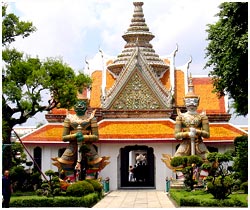The jutting central prang of the temple is girdled by four other smaller prangs. King Rama II started their construction in the early part of the 19th century. However, the project saw completion under his successor, King Rama III. These prang display a unique architectural design, inspired by both Khmer and Thai styles. Not only in architectural design, but also in decoration, they exhibit singularity. The bricks of the structures, layered with plaster, are glued with glossy ceramic tiles and Chinese porcelain. The jutting central prang of the temple is girdled by four other smaller prangs. King Rama II started their construction in the early part of the 19th century. However, the project saw completion under his successor, King Rama III. These prang display a unique architectural design, inspired by both Khmer and Thai styles. Not only in architectural design, but also in decoration, they exhibit singularity. The bricks of the structures, layered with plaster, are glued with glossy ceramic tiles and Chinese porcelain.
 Apart from their architectural grandeur, prangs also hold a lot of
religious significance. The central prang is a symbolic representation
of Mount Meru of Indian cosmology, believed to be the home of the Gods
and the four smaller prangs represent the four winds. In addition, each
of the smaller prangs is topped with a statue of Pai, God of the Winds.
The square formed by the smaller prangs have pavilions containing Buddha
images, illustrating the four stages of his life - birth, meditation,
preaching and enlightenment.
Apart from their architectural grandeur, prangs also hold a lot of
religious significance. The central prang is a symbolic representation
of Mount Meru of Indian cosmology, believed to be the home of the Gods
and the four smaller prangs represent the four winds. In addition, each
of the smaller prangs is topped with a statue of Pai, God of the Winds.
The square formed by the smaller prangs have pavilions containing Buddha
images, illustrating the four stages of his life - birth, meditation,
preaching and enlightenment.The inside of the temple is equally fascinating, with carved images and motifs. Ubosoth Hall (Bot or Ordination Hall) is next to prangs and carved with delicate patterns. It houses a Niramit Buddha image, designed by King Rama II. There is a roof with a central spire on the entrance of the Hall, bedecked in colored ceramic and stuccowork. Two huge temple demons guard the front. Besides, there are mythical gardens in the temple ground, with many other small prangs. No doubt, Wat Arun earns credit as one of the best Buddhist temples of the city. The charges for entering the prang compound of the Wat is 20 Baht (0.63 USD).



